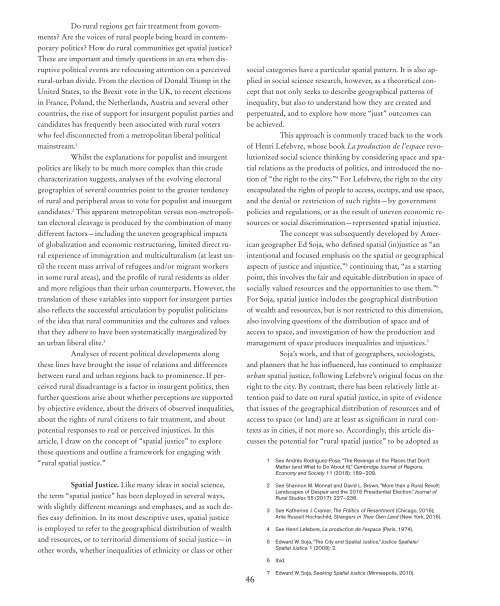Territorial Justice
ISBN 978-3-86859-855-1
ISBN 978-3-86859-855-1
Erfolgreiche ePaper selbst erstellen
Machen Sie aus Ihren PDF Publikationen ein blätterbares Flipbook mit unserer einzigartigen Google optimierten e-Paper Software.
Do rural regions get fair treatment from governments?<br />
Are the voices of rural people being heard in contemporary<br />
politics? How do rural communities get spatial justice?<br />
These are important and timely questions in an era when disruptive<br />
political events are refocusing attention on a perceived<br />
rural-urban divide. From the election of Donald Trump in the<br />
United States, to the Brexit vote in the UK, to recent elections<br />
in France, Poland, the Netherlands, Austria and several other<br />
countries, the rise of support for insurgent populist parties and<br />
candidates has frequently been associated with rural voters<br />
who feel disconnected from a metropolitan liberal political<br />
mainstream. 1<br />
Whilst the explanations for populist and insurgent<br />
politics are likely to be much more complex than this crude<br />
characterization suggests, analyses of the evolving electoral<br />
geographies of several countries point to the greater tendency<br />
of rural and peripheral areas to vote for populist and insurgent<br />
candidates. 2 This apparent metropolitan versus non-metropolitan<br />
electoral cleavage is produced by the combination of many<br />
different factors—including the uneven geographical impacts<br />
of globalization and economic restructuring, limited direct rural<br />
experience of immigration and multiculturalism (at least until<br />
the recent mass arrival of refugees and/or migrant workers<br />
in some rural areas), and the profile of rural residents as older<br />
and more religious than their urban counterparts. However, the<br />
translation of these variables into support for insurgent parties<br />
also reflects the successful articulation by populist politicians<br />
of the idea that rural communities and the cultures and values<br />
that they adhere to have been systematically marginalized by<br />
an urban liberal elite. 3<br />
Analyses of recent political developments along<br />
these lines have brought the issue of relations and differences<br />
between rural and urban regions back to prominence. If perceived<br />
rural disadvantage is a factor in insurgent politics, then<br />
further questions arise about whether perceptions are supported<br />
by objective evidence, about the drivers of observed inequalities,<br />
about the rights of rural citizens to fair treatment, and about<br />
potential responses to real or perceived injustices. In this<br />
article, I draw on the concept of “spatial justice” to explore<br />
these questions and outline a framework for engaging with<br />
“rural spatial justice.”<br />
Spatial <strong>Justice</strong>. Like many ideas in social science,<br />
the term “spatial justice” has been deployed in several ways,<br />
with slightly different meanings and emphases, and as such defies<br />
easy definition. In its most descriptive uses, spatial justice<br />
is employed to refer to the geographical distribution of wealth<br />
and resources, or to territorial dimensions of social justice—in<br />
other words, whether inequalities of ethnicity or class or other<br />
social categories have a particular spatial pattern. It is also applied<br />
in social science research, however, as a theoretical concept<br />
that not only seeks to describe geographical patterns of<br />
inequality, but also to understand how they are created and<br />
perpetuated, and to explore how more “just” outcomes can<br />
be achieved.<br />
This approach is commonly traced back to the work<br />
of Henri Lefebvre, whose book La production de l’espace revolutionized<br />
social science thinking by considering space and spatial<br />
relations as the products of politics, and introduced the notion<br />
of “the right to the city.” 4 For Lefebvre, the right to the city<br />
encapsulated the rights of people to access, occupy, and use space,<br />
and the denial or restriction of such rights—by government<br />
policies and regulations, or as the result of uneven economic resources<br />
or social discrimination—represented spatial injustice.<br />
The concept was subsequently developed by American<br />
geographer Ed Soja, who defined spatial (in)justice as “an<br />
intentional and focused emphasis on the spatial or geographical<br />
aspects of justice and injustice,” 5 continuing that, “as a starting<br />
point, this involves the fair and equitable distribution in space of<br />
socially valued resources and the opportunities to use them.” 6<br />
For Soja, spatial justice includes the geographical distribution<br />
of wealth and resources, but is not restricted to this dimension,<br />
also involving questions of the distribution of space and of<br />
access to space, and investigation of how the production and<br />
management of space produces inequalities and injustices. 7<br />
Soja’s work, and that of geographers, sociologists,<br />
and planners that he has influenced, has continued to emphasize<br />
urban spatial justice, following Lefebvre’s original focus on the<br />
right to the city. By contrast, there has been relatively little attention<br />
paid to date on rural spatial justice, in spite of evidence<br />
that issues of the geographical distribution of resources and of<br />
access to space (or land) are at least as significant in rural contexts<br />
as in cities, if not more so. Accordingly, this article discusses<br />
the potential for “rural spatial justice” to be adopted as<br />
1 See Andrés Rodríguez-Pose, “The Revenge of the Places that Don’t<br />
Matter (and What to Do About It),” Cambridge Journal of Regions,<br />
Economy and Society 11 (2018): 189–209.<br />
2 See Shannon M. Monnat and David L. Brown, “More than a Rural Revolt:<br />
Landscapes of Despair and the 2016 Presidential Election,” Journal of<br />
Rural Studies 55 (2017): 227–236.<br />
3 See Katherine J. Cramer, The Politics of Resentment (Chicago, 2016);<br />
Arlie Russell Hochschild, Strangers in Their Own Land (New York, 2016).<br />
4 See Henri Lefebvre, La production de l’espace (Paris, 1974).<br />
5 Edward W. Soja, “The City and Spatial <strong>Justice</strong>,” <strong>Justice</strong> Spatiale/<br />
Spatial <strong>Justice</strong> 1 (2009): 2.<br />
6 Ibid.<br />
46<br />
7 Edward W. Soja, Seeking Spatial <strong>Justice</strong> (Minneapolis, 2010).


















